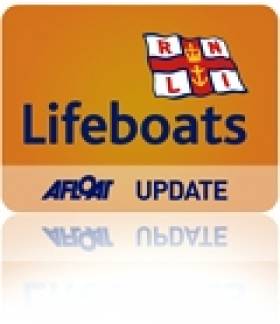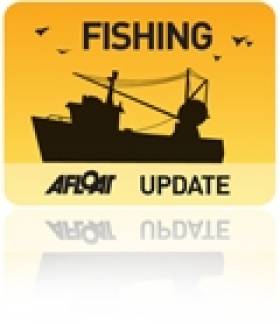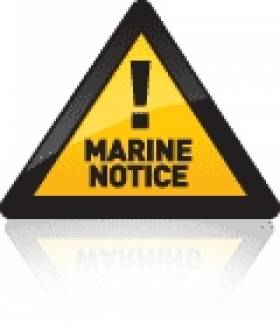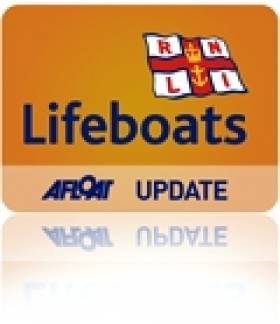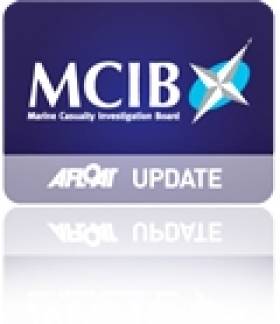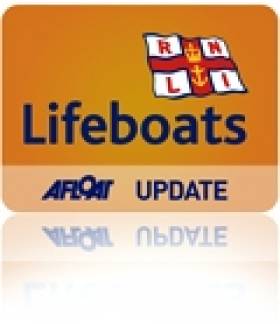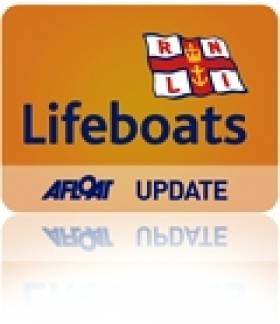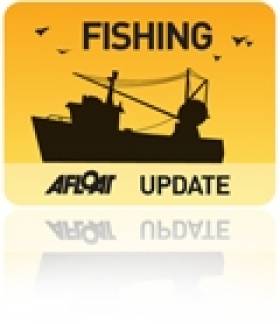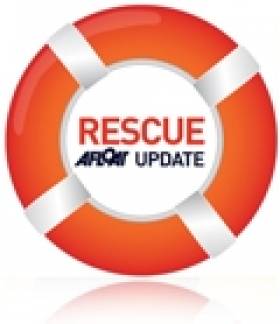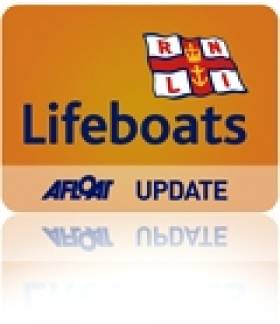Displaying items by tag: castletownbere
Castletownbere RNLI Lifeboat Help Injured Couple After Yacht Gets Into Difficulty Off Bere Island
#rnli – Lifeboat crew with Castletownbere RNLI launched yesterday (30 July 2014) to help a couple who had become injured when the 40 ft yacht they were sailing on, at Lawrence Cove, got into difficultly. On arriving at the scene, the lifeboat crew had to board the vessel and treat the injured woman before bringing the couple to safety at Castletownbere harbour in Cork.
The call for help was raised at 1.28pm, with the lifeboat arriving on scene fifteen minutes later. A local passenger vessel had been passing when the couple got into trouble and was able to offer assistance.
When the lifeboat came alongside the yacht, three of the volunteer lifeboat crew boarded the vessel and administered first aid to the couple. They did not wish to move the woman as she had received injuries to her back, so the lifeboat crew stayed onboard the yacht and returned with it to the shore. On arrival they were transferred to Cork University Hospital.
Commenting on the callout Castletownbere RNLI crewmember Paul Stevens said, 'Thankfully conditions were calm and we were able to reach the couple quickly. It was also fortunate to have the assistance of the local ferry when the lifeboat crew arrived and we are very grateful to them. The couple had sustained injuries when their yacht had got into difficulty and our priority was to get them back to shore as quickly and comfortably as possible. We wish them both a speedy recovery.'
Spanish Fisherman Fined for Illegal Fishing Activity
#fishing – Following a conviction at Cork Circuit Court, today, Friday 28th February, the Master of a Spanish fishing vessel was fined a total of €2,500 and forfeited €80,000, being the assessed value of his catch and a further €12,500 for the fishing gear onboard. Jesus Ramon Rea Rosales, Master of the fishing vessel Armaven Dos, pleaded guilty to the under-recording of monkfish in the vessel's EU logbook. The case arose during the course of a routine inspection of the Armaven Dos on the 5th August 2013, at Castletownbere, Co Cork, by Sea-Fisheries Protection Officers of the Sea-Fisheries Protection Authority (SFPA).
Sea-Fisheries Protection Officers inspected the vessel's onboard catch and when compared to its fishing logbook they discovered approximately 13 tonnes of monkfish retained onboard of which almost seven tonnes were unrecorded. In addition to the under-recording of monkfish, a substantial quantity of Megrim was also found to be unrecorded. The under-recording of catch is contrary to European Community Regulations as fishermen are required to keep an accurate record in the vessel's logbook of the fish they have onboard so that the catch limits and quotas imposed to protect these fish stocks are respected.
Susan Steele, Chair of the SFPA welcomed the outcome of the case and said: ""It is essential that all fishermen play their part in the rebuilding of damaged fish stocks such as monkfish if fishing is to be sustainable and profitable into the future. The requirement for fishermen to accurately record their catches and to keep within quota limits is a cornerstone of measures to rebuild damaged fish stocks and to share the burden of this stock recovery fairly among fishermen. The SFPA's inspection programme is intended to detect illegally caught fish and to protect the livelihoods of the many fishermen who respect the rules in place that safeguard the sustainable exploitation of valuable fish stocks. Stock recovery is good news for fishermen and ultimately leads to better fishing possibilities for the sector as well as improved market supply for consumers."
Construction Works to Commence at Castletownbere Fishery Harbour Centre
#castletownbere –The Department of Transport, Tourism and Sport has been advised that construction works will commence at Castletownbere Fishery Harbour Centre, Co. Cork on or around 30th January 2014, weather permitting. The works will involve the installation of new piles, pontoons and gangway at Barrack Quay and on the Mainland Quay at the western end adjacent to the slipway.
A workboat will be used to move the pontoons and a mobile crane will be operating from the shore to install the piles, pontoons and gangways.
For safety reasons, mariners are requested to proceed slowly and with caution in the approach to the Barrack Quay and the western end of the mainland Quay of the Fishery Harbour Centre and to give the works a wide berth. Wave-wash from vessels should be avoided.
These works are expected to be on-going until mid March 2014, weather permitting.
For further information, contact Castletownbere Harbourmaster's Office Tel: + 353 (0)27 70220
#RNLI - The Castletownbere RNLI volunteer lifeboat crew have aided in the recovery of the body of a man from the sea some 2.4km off Travarra on the Beara Peninsula in West Cork.
The lifeboat launched at 1.35pm yesterday afternoon (Monday 22 July) and was joined by Irish Coast Guard helicopter Rescue 115, Derrynane inshore rescue and the Castletownbere coastguard.
A man believed to be in his earl 20s was sighted in the water at Travarra at around 2.30pm and recovered by a local vessel before being transferred onto the RNLI lifeboat and returned to Castletownbere. He was pronounced dead at the scene by a doctor.
Commenting on the call-out, Castletownbere RNLI deputy coxswain Paul Stevens said: “This is a terrible tragedy and we extend our sympathies to the young man’s family and friends.”
Dinghy Drowning Report Blames Poor Planning
#MCIB - Marine investigators have reiterated the importance of boaters informing people ashore of planned trips in their report into the drowning of a dinghy sailor in West Cork last autumn.
As reported last August on Afloat.ie, an afternoon sail by a father and son from the Beara Peninsula ended in tragedy after their Enterprise sailing dinghy capsized.
The body of John O'Leary from Allihies was found around 1.30am on Tuesday 14 August, just hours after he and his 18-year-son Christy had abandoned their overturned vessel to attempt the swim to shore.
The official report by the Marine Casualty Investigation Board (MCIB) found that the two had been sailing without incident in the area between Cod's Head and the Cullogh Rock for an hour or so before a gust of wind flipped their dinghy.
Unable to right the vessel, the O'Learys rested on the upturned hull to await assistance. But after many hours had passed and suspecting that the hull was starting to sink, they decided to swim to the shoreline some 800 metres away.
With 200 metres to go, John O'Leary encouraged his son to swim ahead to raise the alarm, which he did minutes later. But in the interim John went missing.
Some time into the search operation launched immediately by Castletownbere RNLI and assisted by the Irish Coast Guard from Allihies, John O'Leary's lifejacket was found in the water, and his body was located shortly after.
The MCIB report found that the Enterprise dinghy the O'Learys were sailing is of a kind notorious for its difficulty to right after capsizing. It was also noted that the craft had an insufficient buoyancy bags, which made it even more difficult to bail out once overturned.
But more importantly, the report found that John O'Leary, as skipper of the dinghy, had not arranged a return time or sailing area with anyone on shore prior to the trip.
"If he had done this, the rescue may have occurred before they decided to enter the water," the report said.
Neither man was wearing a wetsuit, exposing them to "the cold and stresses from the cold" which may have "impaired their decision making process" and prompted their decision to swim from the vessel, it added.
In its recommendations, the MCIB advises all sailors to inform a responsible person ashore of their itinerary, and to stay with their vessel as long as possible in the event of any incident on the water.
The full report into the dinghy capsize is available to download below.
Castletownbere RNLI has officially opened its new lifeboat station and facilities on the Beara Peninsula in West Cork. The entire project cost €950,000 and has resulted in the volunteer lifeboat crew moving from the temporary accommodation, where they were based for 15 years, to a more central location. The move has resulted in the launch time of the lifeboat being halved.
Over four hundred people turned out for the ceremony and service of dedication where afterwards they took the opportunity to take a tour of the new station and pontoon, where the all-weather lifeboat Annette Hutton is moored.
Accepting the station and facilities into the care of the Institution, John Coyle, Chairperson of the RNLI Irish Council said, "This day stands as a testament to years of hard work by the people of Castletownbere. Long before there was a station here the people of Castletownbere supported the lifeboats. What this station has achieved in less than two decades is nothing short of remarkable.
Today we spare a thought for those whom we have lost to the sea and we hope that this station will be a symbol of hope and reassurance to those families whose loved ones are involved with the sea whether through work or pleasure."
Aflaot.ie correspondent Tom MacSweeney officially declared the facilities open. Speaking about the station he said, "This is an impressive building, providing facilities which are essential for the lifeboat crew and to which they are entitled. They deserve every support and facility in the difficult and dangerous task which they undertake; saving lives at sea.
The modern facilities here might only have been the dream of past lifeboat crews, today they are welcome, adding to this voluntary service. There is no greater service which a human being can give to another than to risk one's own life. May you always be available to those in peril from the sea and may the sea always be kind to you."
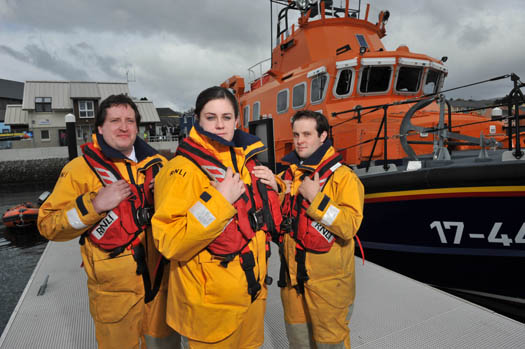
Castletownbere RNLI volunteer lifeboat crew L-R Killian Martin-Sullivan, Ciara O’Driscoll and Cian Murphy at yesterday's new station opening. Photo: Provision
Speaking on behalf of all the volunteers involved with Castletownbere RNLI, Lifeboat Operations Manager Tony O'Sullivan concluded, "Castletownbere lifeboat is well equipped to provide a first class rescue service to all marine traffic in the vicinity. Together with other organisations the crew in Castletownbere provides an excellent service to their community. The crew is ready and willing to respond to a call for help no matter what time of day and whatever the weather."
The volunteer lifeboat crew moved into the new station late last year after spending 15 years in temporary accommodation at Dinish Island. The ambitious building project includes a two storey lifeboat station with an adjoining pontoon from where the station's Severn class all weather lifeboat launches. The station houses a crew changing room, RNLI shop, training room and an operations office.
Casltetownbere RNLI has launched 223 times since the lifeboat was first put on service. Its crews have rescued 288 people and saved 30 lives. Last year alone, the lifeboat launched 10 times, bringing 12 people to safety. Five of those services took place in the dark while the volunteer crew spent 258 service hours at sea.
Among those in attendance at the event were John Nolan, Chairman of the Castletownbere RNLI Lifeboat Management Group, Father Sean O'Shea, RNLI Chaplain and Reverend Paul Willoughby, who both performed a service of dedication.
Castletownbere RNLI Lifeboat Opens New Station Today
Castletownbere RNLI will today officially open its new lifeboat station in west county Cork.
Afloat.ie correspondent Tom MacSweeney will declare the building open at a special ceremony beginning at 2.30pm which will include a service of dedication where the boathouse will be blessed and the official handing over of the station from the institution to Castletownbere RNLI.
The event will mark a significant milestone in the station's 16 year history as the new building and facilities will greatly enhance the operational capability of Castletownbere's all-weather Severn class lifeboat Annette Hutton, and support the crew in their work of saving lives at sea.
The volunteer lifeboat crew moved into the new station late last year after spending 15 years in temporary accommodation at Dinish Island.
The new station and pontoon has been built on reclaimed land in Castletownbere and the new location means that the lifeboat crew can respond to callouts even faster.
The entire project cost €950,000 and includes a two storey lifeboat station with an adjoining pontoon from where the station's Severn class all weather lifeboat launches. The station houses a crew changing room, RNLI shop, training room and an operations office.
The building was designed by Gordon Philips who has worked on seven RNLI lifeboat stations for the charity. Work on the lifeboat station was carried out by Castletownbere construction and the pontoon was constructed by Crowley Engineering in Cork.
The project was made possible by the provision, from the Department of Agriculture, Food and Marine, to the RNLI of a plot of reclaimed land on which the station was built. It has provided the lifeboat crew with the perfect location from which to launch.
Casltetownbere RNLI has launched 223 times since the lifeboat was first put on service. Its crews have rescued 288 people and saved 30 lives. Last year alone, the lifeboat launched 10 times, bringing 12 people to safety. Five of those services took place in the dark while the volunteer crew spent 258 service hours at sea.
Throughout its history, there have been a great variety of call outs - sometimes long in duration, sometimes brief. There have been moments of humour and occasionally tragic circumstances. Two particular rescues, undertaken in difficult circumstances received commendation from the RNLI's Operations Director Michael Vlasto. These included the rescue of a seriously injured fisherman on the Skellig Dawn in February 2002 and the rescue of the Saint Gothard in February 2007.
Back in August 2004, when the station's crew travelled to RNLI Headquarters in Poole to receive their Severn class all weather lifeboat, they brought the Queen who was officially opening the RNLI College for a trip around the harbour on their new lifeboat.
In July 2007, Castletownbere launched with their neighbours in Baltimore following reports of a capsized rib in heavy seas with one man missing. While the man was rescued by lifeboat crew, the call out turned out to be part of the biggest drugs seizure in the state making headlines across the world.
Speaking ahead of this afternoon's ceremony, Paul Stevens, Castletownbere RNLI Second Coxswain and Volunteer Lifeboat Press Officer said the opening ceremony will provide a special opportunity for the West Cork community to welcome the station's new home: 'Since Castletownbere lifeboat station was established in 1997, we have been very fortunate in the level of support we have received both locally and from further afield. We have dedicated lifeboat volunteers and supporters and now we have a station that reflects that. The official opening ceremony will give us the opportunity to thank all those who organised fundraising activities, events, contributed financially or helped in any way to get us to this point as well as allowing us to acknowledge and thank our crew both past and present.'
Among those who will join Tom MacSweeney in officiating at today's ceremony will be John Nolan, chairman of the Castletownbere RNLI Lifeboat Management Group, John Coyle, chairman of the Irish RNLI Council, Tony O'Sullivan, Castletownbere RNLI Lifeboat Operations Manager, Father Sean O'Shea, RNLI Chaplain and Reverend Paul Willoughby
€1billion of Fish Annually Taken from Irish National Waters – Fishing for Justice Website
A website launched by West Cork fishermen says now is the time to reform the Common Fisheries Policy because 'Ireland continues to gift the EU with €1billion of fish annually from Irish national waters'.
The website is supported with significant statistics showing Ireland's low rights compared with European neighbours.
Ireland, a peripheral island with some of the richest fishing waters in the E.U. and a three thousand mile coastline, get a mere 4% of the valuable demersal (bottom feeding fish) quotas. This is meant to serve over 2,000 vessels while, as the website says 'our so called partners take over one billion Euro per annum from what we call our water'.
More on http://fishingforjustice.eu
Five Rescued From Stranded Fishing Vessel Off West Cork
#Rescue - The Irish Times reports on the rescue of five fishermen of West Cork this morning (21 February) after their fishing trawler was stranded in strong coastal winds.
RNLI Castletownbere's lifeboat crew responded to the trawler Anders Nees after its propeller fouled some 6km south of Bere Island in the early hours.
The stricken fishing boat was subsequently towed back to Castletownbere.
New Lifeboat Station for Castletownbere RNLI
#RNLI - The Southern Star reports that Castletownbere RNLI in West Cork has a found a permanent home with the construction of a new station and pontoon.
Coxswain Brian O'Driscoll told the paper that the new station was "a long time coming".
The new €950,000 facility, replacing temporary accommodation that the lifeboat crews had occupied for 15 years, was build on reclaimed land provided by the Department of the Marine.
It comprises a two-storey lifeboat station and a pontoon from where the all-weather lifeboat can be launched for missions such as the fishing trawler grounded off Bere Island last month.
When completed, the building will also boast a crew changing room, training room, operations office and a charity shop.
The new station is scheduled to be open in the spring. The Southern Star has more on the story HERE.


























